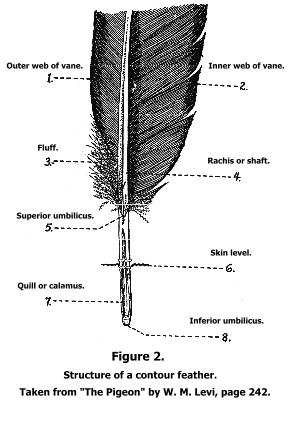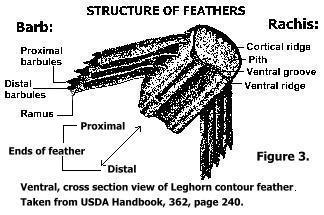American Pigeon Journal
August 1989, pages 32-34.
By Robert J. Mangile
816 E. Atkinson Ave.
Pittsburg, Kansas 66762
Ask the average person to start
counting flight feathers on a pigeon and almost surely they would start
counting from the largest feather at the tip of the wing.
Erroneously,
calling it the first flight and increasing the count as they move
toward the body of the bird.
A system for naming the various structural aspects and the numbering of
feather positions has already been established by the scientific
community. In a two volume book entitled "Avian Anatomy
Integument", details of feathers, primarily from the chicken, turkey,
duck, coturnix
and the common pigeon are discussed in great depth. A book more
accessible to the average pigeon fanciers is "The Pigeon" by W.M. Levi,
which gives much information on pigeon feathers.
A proper method of counting remiges (flights) and rectrices (tail
feathers) can be seen in the sketch in Figure #1.
Notice that the
flight on the end of the wing is the tenth... not the first
flight. The
numbering starts where the primaries and secondaries meet; therefore,
the first primary and the first secondary are in the middle of the
expanded wing. The usual number of primaries and tail feathers
(in
the wildtype) is ten and twelve respectively. Occasionally, fewer or
extra flights and tail feathers may be found. The Fantail pigeon always
has extra tail feathers.
The total number of feathers found on a bird species varies with the
individual and according to which types, of feathers are counted.
A
total feather count for the pigeon was not listed in "Avian Anatomy
Integument"; but, some other bird species were. One chart lists
the
Mourning Dove = 2,635, House Sparrow = 1,359 and the Ruby- throated
Hummingbird = 940. Other counts have the Laughing Dove,
(Streptopelia senegalensis), with 4,210; Green-winged Teal 11,450 and
the Whistling Swan 25,216. Chicken breeds varied, from roughly
6,000 to
9,000.

In addition to the number of feathers, there are several different
types of feather. The hair-like feathers found on a plucked
chicken are
called 'filoplumes'. The stiff 'bristle' feathers found primarily
on the heads of many birds (owls, turkeys and others; but, not on
pigeons) and the 'down' feathers (of which one type called 'natal down'
is found on young pigeons) are among the various feather types.
But, the predominant feathers on a bird's body are called 'contour'
feathers. There are the two types of contour feathers most
familiar to
pigeon fanciers. They are the typical body feathers and another
type
which includes the flights (remiges) and tail feathers (rectrices).
The structure of contour feathers, including the remiges and
rectrices,
has been well studied and the various structural aspects have been
assigned names. The sketch in Figure #2 identifies some of
them. The
hollow portion of the feather shaft extending beneath the skin is
called the 'calamus'. The solid portion that bears the barbs is
called the 'rachis', which usually curves downward and inward.
Both remiges and rectrices overlap so that when closed the outermost
feathers fold beneath the adjacent feather and in the case of the
flights, are closest to the body.
The sketch in Figure #3, depicting a cross section view of a contour
feather from a Leghorn chicken, shows that the rachis is generally
four-sided
and slightly wider than thick and has a depression on the under surface
called the 'ventral groove'. 'Barbs' grow from the convex sides
of the rachis forming the vanes. The outer 'web' of the
'vane'
is
always narrower than the inner (on flights) and this feature allows
determination of whether a flight is either from the left
or right side
of the bird.

The study of feathers is really a complex and tedious task. There
are
many specific details not touched upon in this brief article.
Beyond
the use of a hand held magnifying glass, most of us cannot
observe a
highly magnified view of a feather. However, you might find some books
that have good sketches, drawings and magnified pictures.
Perhaps you
may be inspired to extend your knowledge beyond what the 'feather
readers' of the pigeon fancy have professed to be the final
truth. A glossary has been included below to assist the
reader.
Glossary:
Avian - of or having to do with birds.
Barb - a hairlike branch growing from the shaft of a feather.
Calamus - the quill of a feather.
Contour feathers - surface plumage determining the contour.
Down - soft fine feathers, as on a young bird.
Flight feather - any larger feather of the wings or tail.
Integument - an outer covering; skin, feathers, hide.
Primary flights - most important flights; outermost flights.
Rachis - the portion of the feather shaft bearing the barbs.
Rectrix - (p1. rectrices); a large tail feather of a bird.
Remix - (pl. remiges); a large quill feather of a bird’s wing.
Secondary flights - of secondary importance, innermost flights.
Vane - the web or flat part of a feather, containing the barbs.
Wildtype - a standard based on the Rock Dove, Columba livia.
References:
"Avian Anatomy Integument' 1972, A.M. Lucas and P.R. Stettenheim, 2
vol., U.S.D.A., Handbook 362.
"The Pigeon", 1957. Wendell M. Levi.

